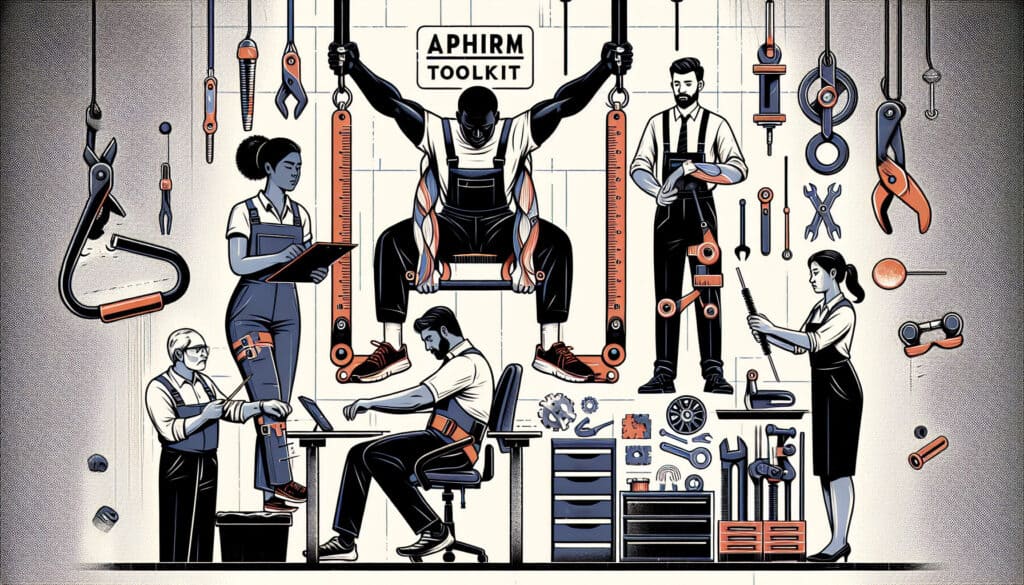Un conjunto de recursos desarrollado en Australia para ayudar a las organizaciones a gestionar los riesgos de trastornos musculoesqueléticos.
- Metodologías: Clientes y marketing, Ideación, Diseño de producto
Herramientas APHIRM

Herramientas APHIRM
- Mejora continua, Ergonomía, Ciencias de la Salud, Human Factors, Mejora de procesos, Gestión de calidad, Gestión de riesgos, Seguridad, Prácticas de sostenibilidad
Objetivo:
Cómo se utiliza:
- El conjunto de herramientas APHIRM (Identificación Participativa de Peligros y Gestión de Riesgos) proporciona una guía paso a paso para identificar, evaluar y controlar los peligros musculoesqueléticos en el lugar de trabajo. Incluye una serie de herramientas prácticas, como listas de comprobación y hojas de trabajo.
Ventajas
- Proporciona un marco práctico y fácil de utilizar para la gestión de los riesgos musculoesqueléticos, se basa en un enfoque participativo y se ha desarrollado específicamente para los lugares de trabajo australianos.
Contras
- Puede no ser aplicable a todos los países o industrias, requiere un compromiso por parte de la dirección y los trabajadores para ser eficaz, y puede no ser adecuado para todos los tipos de riesgos musculoesqueléticos.
Categorías:
- Ergonomía, Recursos Humanos, Gestión de riesgos
Ideal para:
- Gestión de los riesgos de trastornos musculoesqueléticos en los centros de trabajo australianos.
El conjunto de herramientas APHIRM es especialmente valioso en sectores como la sanidad, la fabricación y la logística, en los que predominan la manipulación manual y las tareas repetitivas. Es aplicable en las distintas fases del proyecto, desde el diseño inicial hasta la implantación y el mantenimiento continuo. Un equipo multidisciplinar, que incluya responsables de salud y seguridad, especialistas en ergonomía y trabajadores de primera línea, suele iniciar el proceso de evaluación de riesgos, garantizando que la evaluación de los peligros se base en las opiniones y experiencias de las personas directamente afectadas. La naturaleza participativa del conjunto de herramientas permite la aportación de una amplia gama de partes interesadas, lo que lo hace adaptable a diferentes entornos y prácticas en el lugar de trabajo. Las herramientas prácticas, como listas de comprobación y hojas de trabajo, promueven el compromiso y facilitan aplicaciones sencillas, independientemente del nivel de experiencia existente en la gestión de riesgos. La integración periódica de la metodología APHIRM en los programas de seguridad en el lugar de trabajo no sólo promueve el cumplimiento de la normativa australiana sobre trabajo seguro, sino que también fomenta una cultura de la seguridad cuyo objetivo es reducir la incidencia de los trastornos musculoesqueléticos. Al garantizar que la gestión de riesgos es una responsabilidad compartida, los lugares de trabajo pueden fomentar el diálogo permanente sobre las medidas de seguridad, lo que conduce a una mejora continua de las prácticas ergonómicas y a mejores resultados en materia de salud para los empleados. A través de su enfoque integrado, el kit de herramientas también sirve como un plan para llevar a cabo sesiones de formación y talleres centrados en la identificación de riesgos y estrategias de mitigación, capacitando a los equipos para abordar de forma proactiva las cuestiones relacionadas con la salud musculoesquelética.
Pasos clave de esta metodología
- Identificar los riesgos musculoesqueléticos mediante evaluaciones y observaciones del lugar de trabajo.
- Evaluar el nivel de riesgo asociado a los peligros identificados utilizando medidas cualitativas o cuantitativas.
- Involucrar a las partes interesadas en el desarrollo de estrategias de control para mitigar los riesgos identificados.
- Aplique las medidas de control elegidas y asegúrese de que todo el personal esté informado.
- Supervisar la eficacia de los controles implantados y recabar la opinión de los empleados.
- Revisar y actualizar periódicamente el proceso de gestión de riesgos para reflejar los cambios en el lugar de trabajo o los riesgos emergentes.
Consejos profesionales
- Incorpore evaluaciones ergonómicas a las evaluaciones periódicas de los flujos de trabajo para detectar peligros sutiles que pueden no ser inmediatamente visibles.
- Utilizar los circuitos de retroalimentación de los empleados participantes para perfeccionar y mejorar continuamente las estrategias de gestión de riesgos basadas en experiencias reales.
- Aprovechar las herramientas de análisis de datos para supervisar las tendencias de los trastornos musculoesqueléticos y adaptar las intervenciones de forma proactiva en función de los patrones identificados.
Leer y comparar varias metodologías, recomendamos el
> Amplio repositorio de metodologías <
junto con otras más de 400 metodologías.
Sus comentarios sobre esta metodología o información adicional son bienvenidos en la dirección sección de comentarios ↓ , así como cualquier idea o enlace relacionado con la ingeniería.
Contexto histórico
1986
(si se desconoce la fecha o no es relevante, por ejemplo "mecánica de fluidos", se ofrece una estimación redondeada de su notable aparición)

Publicaciones relacionadas
Cuestionarios sobre molestias musculoesqueléticas
Pruebas multivariantes (MVT)
Análisis de regresión múltiple
Sistemas de captura de movimiento
Método MoSCoW
Prueba de la mediana de Mood